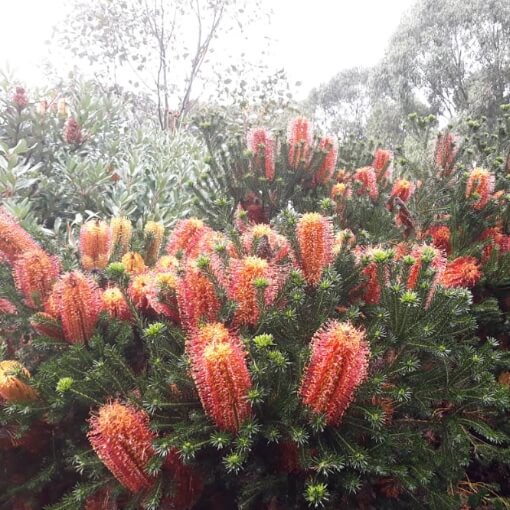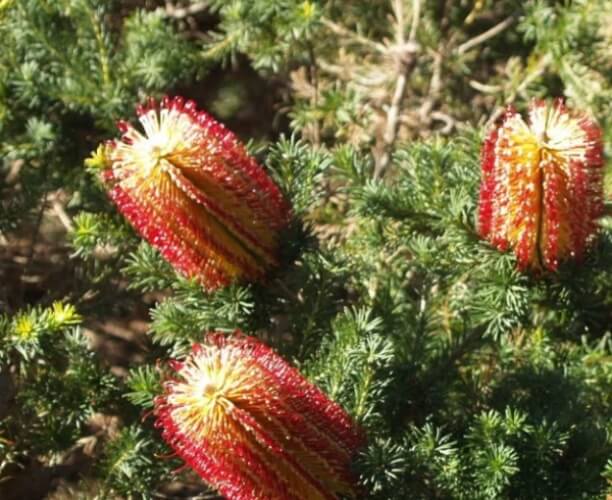Banksia ericifolia is an iconic and popular Australian native plant. They are prolific flowers and have a thick dense habit, making them very attractive for nectar-eating birds, bees, and other wildlife.
A low maintenance plant that grows well in most climates and soils with good drainage. It is also available in a smaller dwarf form. They are one of the most common and well-loved Banksias in Australian gardens.
This guide outlines how to grow and care for one of its most common cultivars, Banksia ‘Little Eric’.
More...
Introducing Banksia ‘Little Eric’
Banksia ericifolia are a species of the Proteaceae family and are native to Australia. It is known by the common name Banksia, Heath banksia, Heath-leaved banksia, and Lantern banksia.
The heath banksia is a small evergreen tree growing to a height of 4-6m and spreads to a width of 3-4m. It has linear, dark green leaves. They produce impressive, large and long lasting orange cylindrical flower spikes.
Banksia ericifolia were one of the first species of Banksia identified and collected by Joseph Banks, around Botany Bay, during the charting of the east coast of Australia in 1770. The genus was named in his honour, hence the name Banksia.
The compact dwarf cultivar Banksia ‘Little Eric’ is the other popular Banksia ericifolia in Aussie backyards.
Banksia ‘Little Eric’ Plant Features
As the size of Aussie gardens continues to shrink, Banksia ericifolia ‘Little Eric’ is becoming increasingly in demand. Commonly known as Dwarf Heath Banksia, Banksia ‘Little Eric’ or simply Little Eric. This is one of the best dwarf banksias you can grow in your garden.
Banksia ‘Little Eric’ is an Australian cultivar that grows well in most regions of Australia. This Banksia ericifolia dwarf is a large shrub which grows to a height of 1.5-2m tall, with a width of 1-1.5m. Banksia ‘Little Eric’ also has large yellow-orange cylindrical flowers.
Established Banksia ericifolia are heat, drought and frost-tolerant plants. They do well in coastal climates.
How to Grow Banksia ‘Little Eric’

Source: The Jungle Collective
Ideal Conditions for Growing Banksia ‘Little Eric’
Best Soil to Use
Banksia ‘Little Eric’ prefers a light, well-drained, slightly acidic, and sandy soil. You can add some organic matter, but they are generally quite happy without any soil modification and are adapted to grow in low nutrient Australian soils.
Banksia ‘Little Eric’ will adapt to and tolerate a wide variety of soils, if well-drained, and can also grow on clay and moist soils. It will even survive some waterlogging.
Where to Position Banksia ‘Little Eric’ in Your Garden
Plant dwarf heath banksia in a sunny, sheltered, and well-drained position in your garden. They will also tolerate a semi shaded position in your garden, where they will still flower.


Get Your Free Guide:
Master Growing Australian Natives eBook
A Must Have Complete Guide for Every Australian Garden
Get Your Free Guide:
Master Growing Australian Natives eBook
A Must Have Complete Guide for Every Australian Garden
They can be grown as a screen, hedge, or feature plant. Try planting Banksia ‘Little Eric’ with other Australian native shrubs, like Grevilleas, to create a dense habitat for small native birds and other wildlife.
Caring for Banksia ericifolia ‘Little Eric’
Dwarf heath banksias are a hardy and low maintenance native plant. Water regularly until the plant is established. This can take a while, so monitor and water as needed during hot summers, for about two years.
Once established, Banksia ‘Little Eric’ rarely requires watering except during extended dry periods. Mulch around the root zone which will help retain water.
Banksia ‘Little Eric’ responds well to pruning. You should trim these native plants to maintain their shape, keep them tidy and encourage flowering. They can get straggly if left to their own devices. Light and regular tip pruning will keep the plant nice and bushy. Avoid hard pruning as this may kill the plant.

Source: Mountain View Nursery
Be careful if applying fertiliser, especially ones with a high phosphorus content, when the plant is young. High doses of phosphorus have the potential to kill the plant, but even small doses can lead to yellowing of leaves. Consider using a specially formulated organic native fertiliser and apply once or twice a year.
They are also generally free from problems with pests and diseases if positioned correctly in the garden and not given inappropriate fertiliser. If planted in a poor draining soil they may become affected by root rot.
When does Banksia ‘Little Eric’ flower?
Heath banksia is famous for their long flowering period and brilliant orange displays. These large and long-lasting flowers will attract birds, bees and other wildlife to your garden, and look absolutely stunning.
Banksia ‘Little Eric’ typically flowers during autumn and winter, from April to August. They produce stunning large, erect cones of stiff, wiry orange flowers.
The tall red orange golden flower cones are distinctive and attractive. The cylindrical flower spikes are typically between 15-20 cm long.
Wrapping Up Our Banksia ‘Little Eric’ Guide
Banksia ‘Little Eric’ are some of the most beautiful Australian natives available for home gardeners. They look great with or without flowers. They are hardy and easy to grow plants, which will attract lots of wildlife.
Do well in a wide range of soils but do require good drainage. Start growing Banksia ‘Little Eric’ today!
Published on October 18, 2023 by Lorri Hopkins
Last Updated on January 25, 2025




